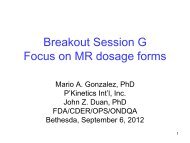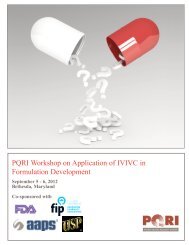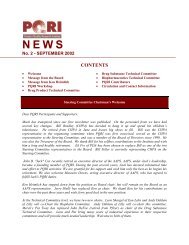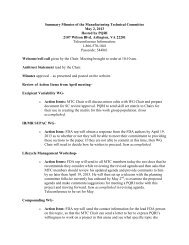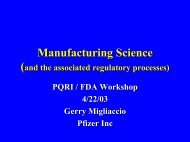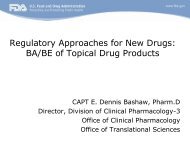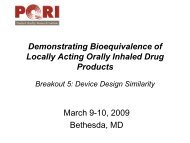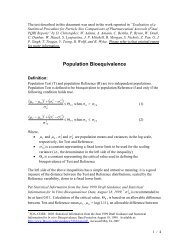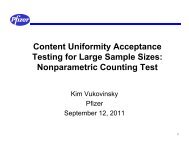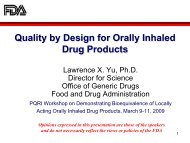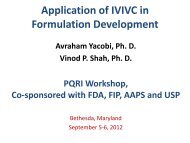Significance of Leachables and Extractables to ... - PQRI
Significance of Leachables and Extractables to ... - PQRI
Significance of Leachables and Extractables to ... - PQRI
You also want an ePaper? Increase the reach of your titles
YUMPU automatically turns print PDFs into web optimized ePapers that Google loves.
<strong>Significance</strong> <strong>of</strong> <strong>Leachables</strong><br />
<strong>and</strong> <strong>Extractables</strong> <strong>to</strong><br />
Pharmaceutical Quality<br />
Gordon Hansen, MS<br />
Vice President Analytical Development<br />
Ridgefield<br />
Boehringer Ingelheim Pharmaceuticals, Inc.
Presentation Outline<br />
• The early days <strong>of</strong> OINDP<br />
– His<strong>to</strong>rical perspective from FDA<br />
– Industry/supplier uncertainty<br />
• CFC replacement <strong>and</strong> IPAC<br />
– An opportunity for change<br />
• Initial regula<strong>to</strong>ry guidance<br />
• IPAC-RS <strong>and</strong> <strong>PQRI</strong><br />
– Removing uncertainty<br />
– Controlling the supply-chain<br />
• Future possibilities
What are OINDP<br />
• Metered Dose Inhalers<br />
• Dry Powder Inhalers<br />
• Inhalation Solutions<br />
• Inhalation Sprays<br />
• Nasal Sprays<br />
MDI Schematic Provided by<br />
Bespak Europe
What Mattered in the “Good Old Days”<br />
• Container closure system component selection<br />
was based on:<br />
– Performance <strong>of</strong> the component relative <strong>to</strong> st<strong>and</strong>ard<br />
parameters (dose delivery, shot weight, etc.)<br />
– Price <strong>and</strong> availability ($$$$$$$$$$$$$)<br />
– (Not necessarily in that order)<br />
• “Off-the-shelf” components were typically selected<br />
<strong>and</strong> used.<br />
• Supplier interactions were rudimentary.<br />
• Change-control was not really a significant issue.
Risk or His<strong>to</strong>ry – L&E in OINDP<br />
• Based on: Alan C. Schroeder, “<strong>Leachables</strong> <strong>and</strong><br />
<strong>Extractables</strong> in OINDP: An FDA Perspective”,<br />
presented at the <strong>PQRI</strong> <strong>Leachables</strong> <strong>and</strong><br />
<strong>Extractables</strong> Workshop, Dec. 5-6, 2005,<br />
Bethesda, MD.<br />
• Evolutionary process for L/E<br />
– Problems observed in specific drug products<br />
– Increasing knowledge about materials <strong>and</strong><br />
manufacturing processes<br />
– Data based
Risk or His<strong>to</strong>ry – L&E in OINDP<br />
(continued)<br />
• How did the importance <strong>of</strong> various<br />
<strong>Leachables</strong>/<strong>Extractables</strong> come <strong>to</strong> the<br />
attention <strong>of</strong> the FDA<br />
– Reports <strong>of</strong> PNAs in elas<strong>to</strong>mers<br />
– PNAs in MDIs<br />
– Nitrosamines in elas<strong>to</strong>mers<br />
– 2-mercap<strong>to</strong>benzothiazole (2-MBT) in<br />
elas<strong>to</strong>mers<br />
– Other classes <strong>of</strong> L/Es
<strong>Leachables</strong> in a Metered Dose Inhaler<br />
Drug Product<br />
canister<br />
drug product formulation<br />
aerosol plume<br />
dose metering valve<br />
drug product (<strong>and</strong> leachables) delivered <strong>to</strong><br />
patient<br />
actua<strong>to</strong>r/mouthpiece
Industry/Supplier Uncertainty<br />
• How should extractables/leachables be<br />
characterized<br />
• How low do you go with such characterizations<br />
• How should extractables/leachables be qualified<br />
• How should extractables/leachables be<br />
controlled<br />
• How should OINDP manufacturers interact with<br />
component suppliers <strong>to</strong>:<br />
– Minimize <strong>and</strong> control component extractables;<br />
– Remove bad ac<strong>to</strong>rs (e.g., PAHs <strong>and</strong> nitrosamines);<br />
– Deal with change-control;<br />
– Secure the supply-chain
CFC Replacement <strong>and</strong> IPAC<br />
• Scientists have found that when CFCs get in<strong>to</strong> the upper regions<br />
<strong>of</strong> the earth's atmosphere (stra<strong>to</strong>sphere), they reduce the amount<br />
<strong>of</strong> ozone in the ozone layer that surrounds the earth, increasing<br />
the risk <strong>of</strong> potentially serious health problems, such as skin<br />
cancer <strong>and</strong> cataracts, as well as other health <strong>and</strong> environmental<br />
problems (http://www.ipacmdi.com/).<br />
• To lower the risk <strong>of</strong> health <strong>and</strong> environmental problems caused<br />
by ozone depletion <strong>and</strong> <strong>to</strong> help res<strong>to</strong>re the ozone layer, most<br />
countries have agreed <strong>to</strong> s<strong>to</strong>p using CFCs. The agreement was<br />
made in 1987 <strong>and</strong> is known as the Montreal Pro<strong>to</strong>col<br />
(http://www.ipacmdi.com/).<br />
• The International Pharmaceutical Aerosol Consortium (IPAC)<br />
formed in 1989 <strong>to</strong> address regula<strong>to</strong>ry consequences for MDIs <strong>of</strong><br />
the Montreal Pro<strong>to</strong>col, <strong>and</strong> <strong>to</strong> help manage the CFC transition <strong>to</strong><br />
alternative propellants (i.e., HFAs) <strong>and</strong> other OINDP forms.
CFC Replacement <strong>and</strong> IPAC (continued)<br />
• Note that the timing <strong>of</strong> the Montreal Pro<strong>to</strong>col <strong>and</strong><br />
the formation <strong>of</strong> IPAC coincided with the period <strong>of</strong><br />
heightened concern regarding E/L.<br />
• Industry responses <strong>to</strong> both E/L concern <strong>and</strong> the<br />
CFC transition included:<br />
– Initiation <strong>of</strong> research programs <strong>to</strong> characterize E/L<br />
related <strong>to</strong> MDIs under development.<br />
– Consideration <strong>of</strong> strategies <strong>to</strong> create “cleaner” MDI<br />
container closure system components.<br />
– Development <strong>of</strong> newer OINDP <strong>to</strong> minimize E/L <strong>and</strong><br />
replace MDIs (e.g., DPIs).<br />
– Begin <strong>to</strong> work more closely with component suppliers<br />
<strong>to</strong> engineer improved components <strong>and</strong> processes.
MDI Component Initial Improvements<br />
• Prewashing (pre-extraction) <strong>of</strong> MDI valve<br />
rubber components.<br />
• Improved degreasing processes for MDI<br />
aluminum <strong>and</strong> stainless steel canisters.<br />
• “Cus<strong>to</strong>m-designed” MDI valve components<br />
(rubber/plastic/metal) with optimized<br />
curing processes <strong>and</strong> additive packages.
An Elas<strong>to</strong>meric Component <strong>Extractables</strong><br />
Pr<strong>of</strong>ile from “The Good Old Days”<br />
GC/MS<br />
“extractables<br />
pr<strong>of</strong>ile” <strong>of</strong> an<br />
organic solvent<br />
extract
Rubber Quality – Then <strong>and</strong> Now<br />
• Old Rubber:<br />
– Carbon black fillers<br />
(PAHs)<br />
– Sulfur cured<br />
(nitrosamines)<br />
– Curing processes <strong>and</strong><br />
additive packages not<br />
optimized (excessive<br />
levels <strong>of</strong> additives <strong>and</strong><br />
curing agents, etc.)<br />
– Unwashed prior <strong>to</strong><br />
use<br />
• Newer Rubber:<br />
– Alternate fillers (no<br />
PAHs/lower PAHs)<br />
– Peroxide cured (no<br />
nitrosamines)<br />
– Curing processes<br />
<strong>and</strong> additive<br />
packages optimized.<br />
(lower levels <strong>of</strong><br />
extractables)<br />
– Washed prior <strong>to</strong> use
Change is Good!!!!!<br />
New MDI elas<strong>to</strong>meric<br />
valve component<br />
Old MDI elas<strong>to</strong>meric<br />
valve component
Effects <strong>of</strong> Pre-washing “Process<br />
Optimized” MDI Valve Components<br />
Unwashed<br />
Development<br />
valve<br />
Pre-washed<br />
Development<br />
valve<br />
• Peroxide cured rubber<br />
• Non-CFC MDI
Effects <strong>of</strong> Pre-washing “Process Optimized”<br />
MDI Valve Components (continued)<br />
Unwashed<br />
Development<br />
valve<br />
Pre-washed<br />
Development<br />
valve<br />
• Peroxide cured rubber<br />
• Non-CFC MDI
DIMETHYLAMINE (N-NITROSO)<br />
DIETHYLAMINE (N-NITROSO)<br />
DIISOPROPYL (N-NITROSO)<br />
MORPHOLINE (N-NITROSO)<br />
PYRROLIDINE (N-NITROSO)<br />
PIPERIDINE (N-NITROSO)<br />
Di-N-BUTYLAMINE (N-NITROSO)<br />
Effects <strong>of</strong> Pre-washing “Process Optimized”<br />
MDI Valve Components (continued)<br />
7000<br />
Representative GC/TEA Chroma<strong>to</strong>gram <strong>of</strong><br />
a 3 ng/canister Spiked MDI canister<br />
6800<br />
6600<br />
Target N-nitrosamines<br />
6400<br />
uV<br />
6200<br />
6000<br />
5800<br />
5600<br />
0 10 20 30 40<br />
Time (min)
Available FDA Guidances<br />
• Container Closure Systems for Packaging Human Drugs <strong>and</strong><br />
Biologics; Guidance for Industry; U.S. Department <strong>of</strong> Health <strong>and</strong><br />
Human Services Food <strong>and</strong> Drug Administration Center for Drug<br />
Evaluation <strong>and</strong> Research (CDER) <strong>and</strong> Center for Biologics<br />
Evaluation <strong>and</strong> Research (CBER); Rockville, MD, May 1999.<br />
“Packaging Guidance”<br />
• Metered Dose Inhaler (MDI) <strong>and</strong> Dry Powder Inhaler (DPI) Drug<br />
Products; Draft Guidance for Industry; U.S. Department <strong>of</strong> Health<br />
<strong>and</strong> Human Services Food <strong>and</strong> Drug Administration Center for Drug<br />
Evaluation <strong>and</strong> Research (CDER); Rockville, MD, Oc<strong>to</strong>ber 1998.<br />
“MDI/DPI Guidance”<br />
• Nasal Spray <strong>and</strong> Inhalation Solution, Suspension, <strong>and</strong> Spray Drug<br />
Products – Chemistry, Manufacturing, <strong>and</strong> Controls Documentation;<br />
Guidance for Industry; U.S. Department <strong>of</strong> Health <strong>and</strong> Human<br />
Services Food <strong>and</strong> Drug Administration Center for Drug Evaluation<br />
<strong>and</strong> Research (CDER); Rockville, MD, July 2002.<br />
“Nasal Spray Guidance”
Gradient <strong>of</strong> <strong>Leachables</strong> “Risk”
• In 2001, the International Pharmaceutical<br />
Aerosol Consortium for Regulation <strong>and</strong><br />
Science (IPAC-RS) was <strong>of</strong>ficially formed<br />
as a separate Consortium.<br />
• IPAC-RS Mission: To advance<br />
consensus-based <strong>and</strong> scientifically<br />
driven st<strong>and</strong>ards <strong>and</strong> regulations for<br />
inhaled <strong>and</strong> nasal drug products<br />
(OINDP).<br />
• IPAC-RS Overall Goal: Development<br />
<strong>of</strong> scientifically justified regula<strong>to</strong>ry<br />
approaches for orally inhaled <strong>and</strong><br />
nasal drug products
IPAC/ITFG Collaboration (1999-2001)<br />
STEERING COMMITTEE<br />
TECHNICAL TEAMS<br />
CMC<br />
TESTS AND METHODS<br />
CMC SUPPLIER<br />
QUALITY CONTROL<br />
CMC SPECIFICATIONS<br />
DCU WG<br />
PSD WG<br />
CMC LEACHABLES &<br />
EXTRACTABLES<br />
TOXICOLOGY WG<br />
BA/BE IN VITRO AND<br />
IN VIVO TESTS<br />
CMC <strong>Leachables</strong> <strong>and</strong> <strong>Extractables</strong><br />
Technical Team
IPAC/ITFG Collaboration (continued)<br />
Team Overview <strong>of</strong> Draft CMC Guidances:<br />
(MDI/DPI <strong>and</strong> Nasal Spray)<br />
Team supported efforts <strong>of</strong> Agency in drafting guidance<br />
documents which address requirements for leachables <strong>and</strong><br />
extractables for orally inhaled <strong>and</strong> nasal drug products.<br />
Team believed that current draft Guidances could be<br />
enhanced by clarification in specific areas.<br />
Team identified key areas <strong>of</strong> draft Guidances which would<br />
benefit from further investigation <strong>and</strong> dialogue with Agency.
IPAC/ITFG Collaboration (continued)<br />
Key Issues <strong>and</strong> Process:<br />
Key Issues for Clarification <strong>and</strong> Agency Dialogue:<br />
•What are appropriate reporting/identification/qualification thresholds for leachables &<br />
extractables<br />
•How is a correlation between leachables <strong>and</strong> extractables established<br />
•What are appropriate practices for establishing safety <strong>of</strong> leachables<br />
•Is extractables pr<strong>of</strong>iling appropriate for control <strong>of</strong> component composition<br />
•Which critical components should be subject <strong>to</strong> routine extractables testing<br />
Collected drug product specific leachables <strong>and</strong> extractables data in order <strong>to</strong><br />
investigate the concept <strong>of</strong> correlation<br />
Formed <strong>to</strong>xicology WG <strong>to</strong> address <strong>to</strong>xicology issues for leachables<br />
Investigated current supplier practices for control <strong>of</strong> component composition <strong>and</strong><br />
extractables pr<strong>of</strong>iles
IPAC/ITFG Collaboration (continued)<br />
Submitted Points <strong>to</strong> Consider (March 2001) technical paper <strong>to</strong><br />
the Agency, which proposed:<br />
Alternate language for the draft Guidances, which<br />
clarifies the requirements for leachables <strong>and</strong> extractables<br />
studies<br />
Reporting <strong>and</strong> qualification thresholds for leachables<br />
A leachables qualification process<br />
Result: A <strong>PQRI</strong> proposal from IPAC-RS
• Product Quality Research<br />
Institute<br />
• Not-for-pr<strong>of</strong>it, non-s<strong>to</strong>ck,<br />
tax-exempt entity<br />
incorporated in Virginia<br />
• Serves as a forum for<br />
academia, industry <strong>and</strong><br />
FDA <strong>to</strong> work<br />
cooperatively<br />
• PODP <strong>Leachables</strong> <strong>and</strong><br />
<strong>Extractables</strong> Working<br />
Group currently in<br />
operation<br />
What is <strong>PQRI</strong>
Highlights <strong>of</strong> <strong>PQRI</strong> Process<br />
• Opportunity <strong>to</strong> collect raw data through<br />
independent experiments/studies, or<br />
through data-mining<br />
• Scrutiny <strong>of</strong> data by scientists from diverse<br />
backgrounds<br />
• Discussion <strong>of</strong> data outside <strong>of</strong> NDA process
His<strong>to</strong>ry <strong>of</strong> <strong>PQRI</strong> OINDP <strong>Leachables</strong> <strong>and</strong><br />
<strong>Extractables</strong> Working Group<br />
• Proposal <strong>to</strong> develop thresholds <strong>and</strong> examine best<br />
practices for L&E in OINDP drafted by IPAC-RS <strong>and</strong><br />
submitted <strong>to</strong> <strong>PQRI</strong><br />
• Working Group formed in 2001, consisting <strong>of</strong> chemists<br />
<strong>and</strong> <strong>to</strong>xicologists from FDA, industry <strong>and</strong> academia<br />
• Working Group developed a hypothesis <strong>and</strong> step-wise<br />
plan <strong>to</strong> investigate per established <strong>PQRI</strong> process<br />
• Workplan approved by <strong>PQRI</strong> DPTC <strong>and</strong> Steering<br />
Committee in 2002<br />
• Toxicologists <strong>and</strong> chemists formed sub-groups
His<strong>to</strong>ry <strong>of</strong> <strong>PQRI</strong> OINDP <strong>Leachables</strong> <strong>and</strong><br />
<strong>Extractables</strong> Working Group<br />
• Toxicologists: acquired data through extensive literature<br />
<strong>and</strong> database searches <strong>and</strong> analyses<br />
• Chemists: acquired data by conducting extractions studies<br />
<strong>and</strong> placebo leachables study<br />
• Developed recommendations, “Safety Thresholds <strong>and</strong> Best<br />
Practices for <strong>Leachables</strong> <strong>and</strong> <strong>Extractables</strong> Testing in Orally<br />
Inhaled <strong>and</strong> Nasal Drug Products”<br />
• Submitted final <strong>to</strong> <strong>PQRI</strong> <strong>and</strong> FDA in summer 2006<br />
‣ Science <strong>and</strong> data-based recommendations <strong>to</strong> <strong>PQRI</strong> <strong>and</strong> FDA. Not<br />
a policy/regula<strong>to</strong>ry document
Why Produce L&E Recommendations<br />
• To reduce uncertainty in the<br />
pharmaceutical development<br />
process for OINDP<br />
• To reduce or eliminate “Horror<br />
S<strong>to</strong>ries”<br />
• To support regula<strong>to</strong>ry<br />
initiatives, such as Quality-by-<br />
Design <strong>and</strong> Risk Management
Recommendations - Best Practices<br />
Overview<br />
• Application <strong>of</strong> safety thresholds<br />
‣ Safety Concern Threshold (SCT)<br />
‣ Qualification Threshold (QT)<br />
• Integration <strong>of</strong> safety expertise in<strong>to</strong> component selection,<br />
controlled extraction studies, leachables studies <strong>and</strong><br />
routine extractables testing<br />
• Analytical/chemistry<br />
‣ Selection <strong>of</strong> components<br />
‣ Controlled Extraction Studies<br />
‣ <strong>Leachables</strong> Studies <strong>and</strong> Routine <strong>Extractables</strong> Testing<br />
‣ The Analytical Evaluation Threshold (AET)
Other Accomplishments <strong>of</strong> the <strong>PQRI</strong> OINDP<br />
<strong>Leachables</strong> <strong>and</strong> <strong>Extractables</strong> Working<br />
Group<br />
• Training courses in the United States, Europe<br />
<strong>and</strong> Canada.<br />
• Peer reviewed publications:<br />
– Pharmaceutical Research<br />
– Toxicological Sciences<br />
• A comprehensive book on leachables <strong>and</strong><br />
extractables (in progress).<br />
• Numerous public scientific presentations <strong>and</strong><br />
short courses (e.g., EAS).
Additional Quality Challenges<br />
• Working with OINDP container closure<br />
system component suppliers <strong>to</strong>:<br />
– Underst<strong>and</strong> <strong>and</strong> secure the supply-chain<br />
– Ensure consistent component quality<br />
– Educate all suppliers about the issues faced by<br />
OINDP manufacturers, including E/L<br />
• Accomplishing the above while accepting the<br />
fact that the OINDP industry represents only<br />
a small fraction <strong>of</strong> business for many<br />
suppliers (i.e., Exxon-Mobile, BASF)<br />
• Thinking about the future (Quality-by-Design)
IPAC/ITFG Collaboration (1999-2001)<br />
STEERING COMMITTEE<br />
TECHNICAL TEAMS<br />
CMC<br />
TESTS AND METHODS<br />
CMC SUPPLIER<br />
QUALITY CONTROL<br />
CMC SPECIFICATIONS<br />
DCU WG<br />
PSD WG<br />
CMC LEACHABLES &<br />
EXTRACTABLES<br />
TOXICOLOGY WG<br />
BA/BE IN VITRO AND<br />
IN VIVO TESTS<br />
CMC Supplier Quality Control Technical Team
Supplier Quality Control Technical Team<br />
Conducted survey <strong>of</strong> suppliers <strong>to</strong> evaluate quality <strong>and</strong><br />
compliance practices at all stages <strong>of</strong> component, excipient,<br />
raw materials, <strong>and</strong> active drug substance manufacture<br />
Received evaluations on 53 supplier companies<br />
Concluded that no generally accepted cGMP guidelines<br />
exist for component supply chains<br />
Endorsed IPEC guideline for control <strong>and</strong> cGMP compliance<br />
<strong>of</strong> excipients<br />
Proposed industry-wide initiative <strong>to</strong> develop cGMP guideline<br />
for component suppliers
Supplier Quality Control Technical Team<br />
(continued)<br />
• Good Manufacturing Practices Guideline for<br />
Suppliers <strong>of</strong> Components for Orally Inhaled <strong>and</strong><br />
Nasal Drug Products (2006)<br />
– Quality Management System<br />
– Management Responsibility<br />
– Resource Management<br />
– Product Realisation<br />
– Measurement Analysis <strong>and</strong> Improvement<br />
– Contamination Control
Other IPAC-RS Initiatives <strong>to</strong> Address Quality<br />
Challenges<br />
• Supplier outreach <strong>and</strong> education (IPAC-RS<br />
Materials Working Group)<br />
– Supplier forums <strong>and</strong> workshops<br />
– Publications<br />
– International outreach<br />
• Quality-by-Design initiative related <strong>to</strong> E/L<br />
(IPAC-RS Development Paradigm Working<br />
Group)<br />
– Unit operations <strong>and</strong> labora<strong>to</strong>ry investigations <strong>of</strong><br />
injection moulding processes for MDI valve<br />
components
Conclusions<br />
• The E/L issue was <strong>and</strong> is a complex <strong>and</strong><br />
technically challenging one for OINDP<br />
manufacturers, component suppliers <strong>and</strong><br />
regula<strong>to</strong>rs.<br />
• Regula<strong>to</strong>ry guidances, pharmaceutical industry<br />
initiatives, <strong>and</strong> industry/regula<strong>to</strong>ry collaborations<br />
have served <strong>to</strong>:<br />
– Remove uncertainty from the pharmaceutical<br />
development process.<br />
– Educate container closure system suppliers <strong>and</strong> help<br />
secure the supply-chain.<br />
– Ensure the quality <strong>of</strong> OINDP.
The Future<br />
• Quality-by-Design<br />
– Ensure OINDP quality while reducing product<br />
testing <strong>and</strong> facilitating change control processes.<br />
• Safety database for leachables<br />
– ELSIE (The <strong>Extractables</strong> <strong>Leachables</strong> Safety<br />
Information Exchange).<br />
– Facilitate safety qualification <strong>of</strong> leachables.<br />
• Additional regula<strong>to</strong>ry guidances<br />
– Potential USP General Chapter on <strong>Extractables</strong>
Acknowledgements<br />
• IPAC-RS <strong>and</strong> its various technical teams <strong>and</strong><br />
working groups<br />
• <strong>PQRI</strong> <strong>and</strong> the <strong>PQRI</strong> OINDP <strong>Leachables</strong> <strong>and</strong><br />
<strong>Extractables</strong> Working Group<br />
• BIPI Ridgefield <strong>and</strong> BIKG Ingelheim RDD staff<br />
• <strong>PQRI</strong> PODP <strong>Leachables</strong> <strong>and</strong> <strong>Extractables</strong><br />
Working Group



